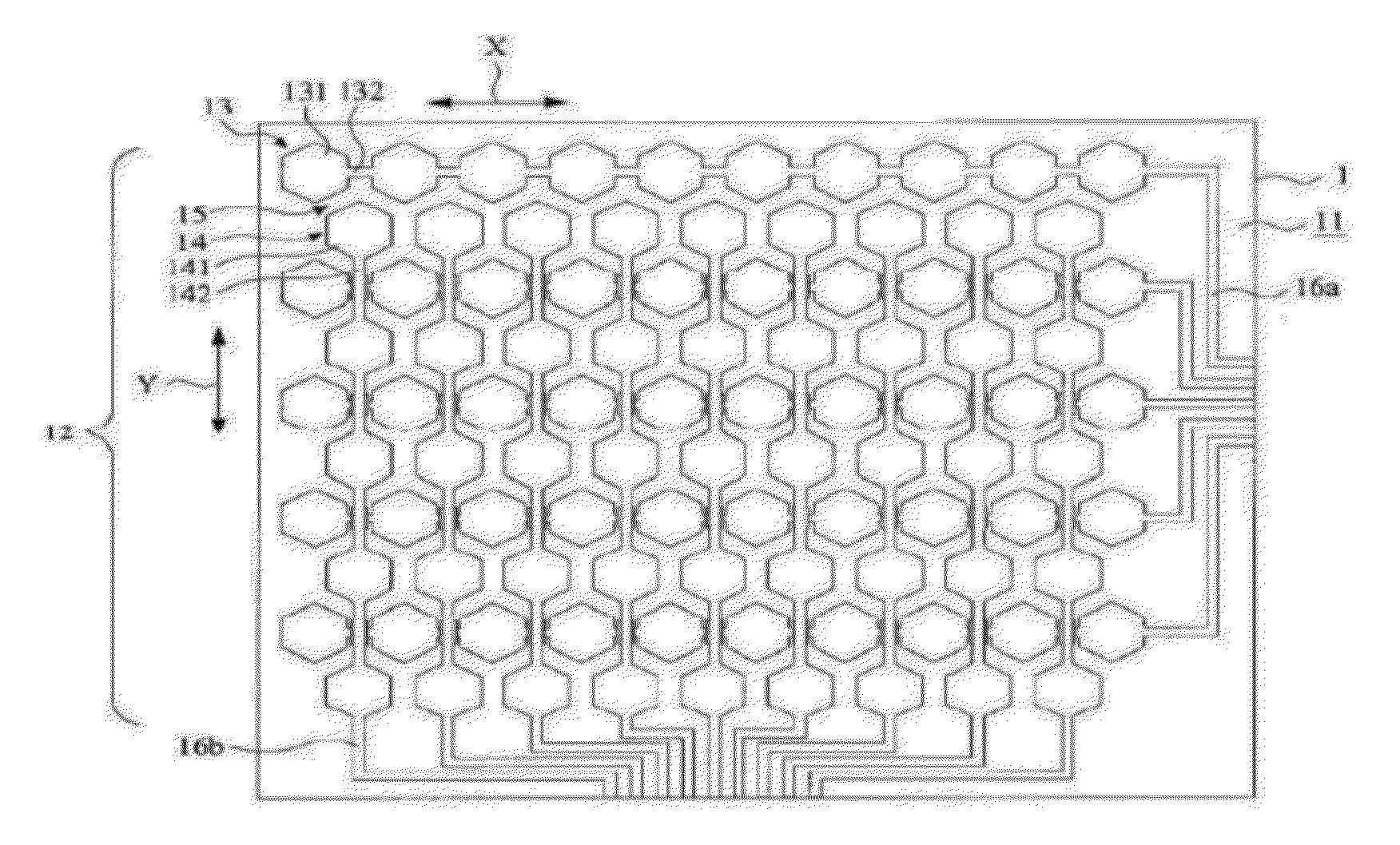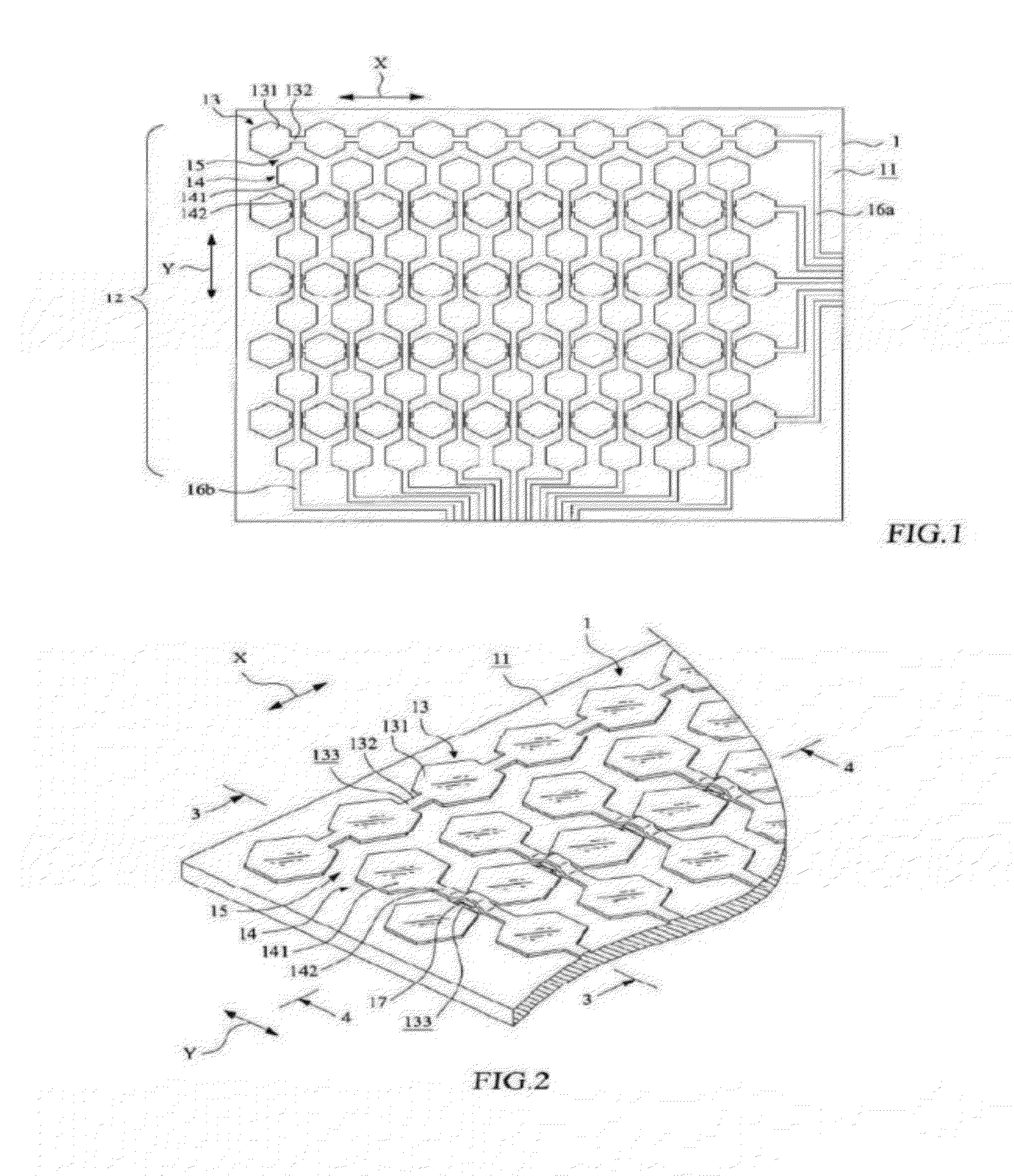Conductor pattern structure of capacitive touch panel
a capacitive touch panel and pattern structure technology, applied in the field of capacitive touch panel devices, can solve the problems of complex manufacturing of capacitive touch panels, high thickness of panel structures, and trend of miniaturization, and achieve the effects of reducing structure thickness, simple process, and simplifying structur
- Summary
- Abstract
- Description
- Claims
- Application Information
AI Technical Summary
Benefits of technology
Problems solved by technology
Method used
Image
Examples
first embodiment
[0042]With reference to the drawings and in particular to FIGS. 1 and 2, of which FIG. 1 illustrates a plan view of a conductor pattern structure of a capacitive touch panel in accordance with the present invention and FIG. 2 illustrates a perspective view of a portion of the conductor pattern structure of the capacitive touch panel, generally designated with reference numeral 12, is formed on a surface 11 of a substrate 1. The conductor pattern structure 12 comprises a plurality of conductor assemblies 13 extending along a first axis, which will be referred to as “first-axis conductor assemblies”, and a plurality of conductor assemblies 14 extending along a second axis, which will be referred to as “second-axis conductor assemblies”. Each of the first-axis conductor assemblies 13 is parallel to other first-axis conductor assemblies 13, and each of the second-axis conductor assemblies 14 is parallel to other second-axis conductor assemblies 14. The first-axis conductor assemblies 13...
second embodiment
[0056]In the embodiment discussed previously, the first-axis conductor cells and the second-axis conductor cells are each formed on the substrate in an array form to constitute the conductor pattern structure of the capacitive touch panel. Based on the same philosophy, a small number of conductor cells can also be used to construct a conductor pattern structure of the capacitive touch panel. This is illustrated in FIG. 10 as the disclosure, wherein two adjacent first-axis conductor cells 31, 32 are formed on a surface 21 of a substrate 2 and a signal transmission line 34 is connected to the conductor cell 32. A first-axis conduction line 33 connects between the adjacent first-axis conductor cells 31,32. An insulation layer 4 is formed on a surface of the first-axis conduction line 33.
[0057]Along an axis that is different from the first-axis conductor cells 31, 32, two adjacent second-axis conductor cells 51, 52 are arranged and a second-axis conduction lines 53 connects between die ...
third embodiment
[0058]FIG. 11 and FIG. 11a show a conductor pattern structure of a capacitive touch panel of the present invention. With reference to FIG. 11, the first-axis conductive cells 31 and 32 are connected by the first-axis conductive line 33, the second-axis conductive cells 51 and 52 are connected by the second-axis conductive lines 53, and the first-axis conductive lines 33 intersect with die second-axis conductive lines 53. The upper surface of the first-axis conductive lines 33 are processed by an insulating treatment to form an insulating layer 332 as shown in FIG. 11a to make the first-axis conductive lines 33 insulated with the second-axis conductive lines. Preferably, the first conductive lines 33 and the second-axis conductive lines 53 can be made of metal such as copper, aluminum, iron, tin, or silver or the mixture or any other metal that the oxide of which are insulating in electrical property and the insulating treatment can be oxide treatment or acidification treatment or al...
PUM
 Login to View More
Login to View More Abstract
Description
Claims
Application Information
 Login to View More
Login to View More - R&D
- Intellectual Property
- Life Sciences
- Materials
- Tech Scout
- Unparalleled Data Quality
- Higher Quality Content
- 60% Fewer Hallucinations
Browse by: Latest US Patents, China's latest patents, Technical Efficacy Thesaurus, Application Domain, Technology Topic, Popular Technical Reports.
© 2025 PatSnap. All rights reserved.Legal|Privacy policy|Modern Slavery Act Transparency Statement|Sitemap|About US| Contact US: help@patsnap.com



